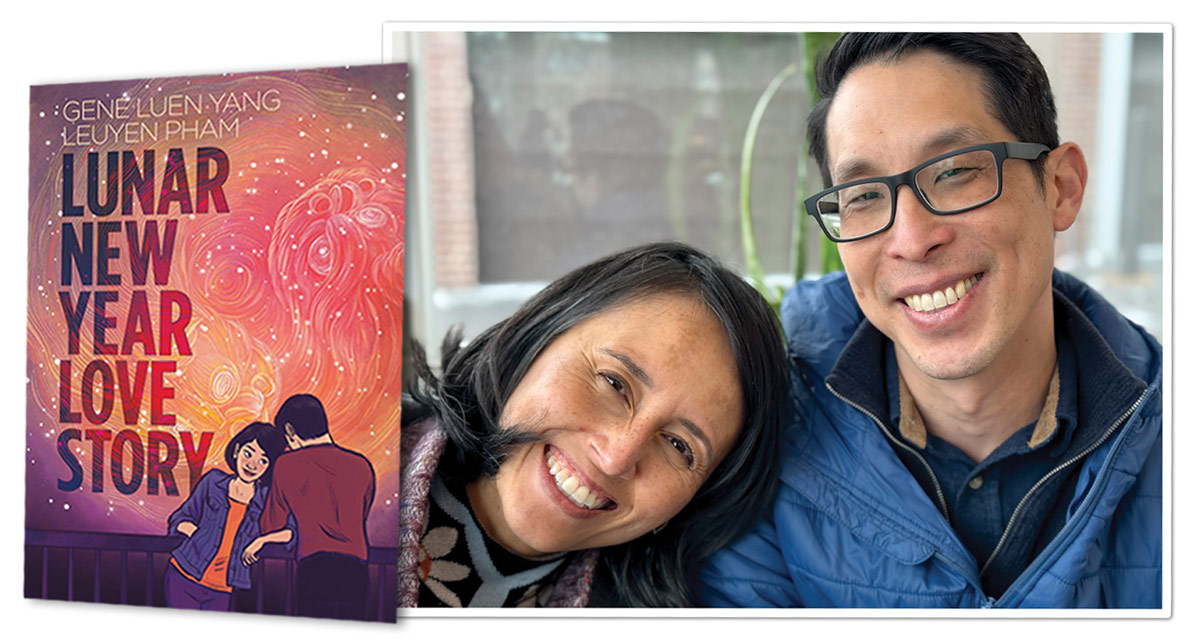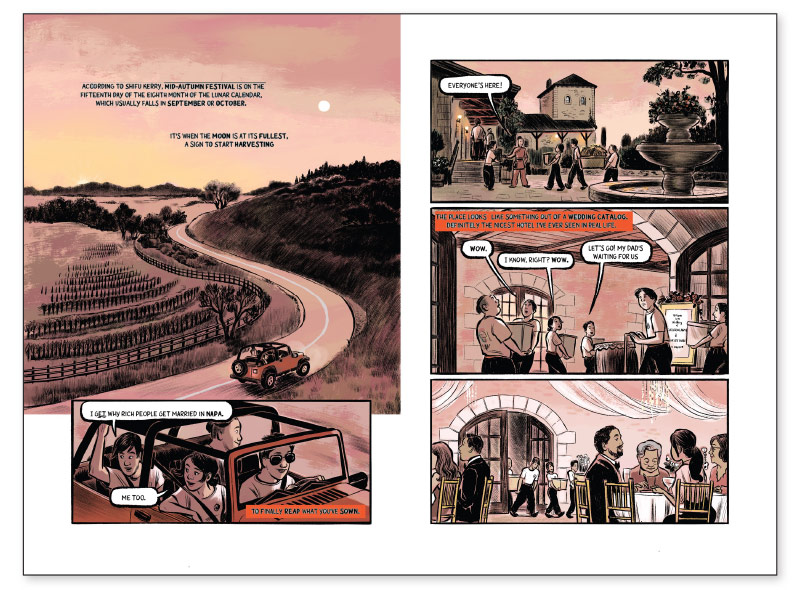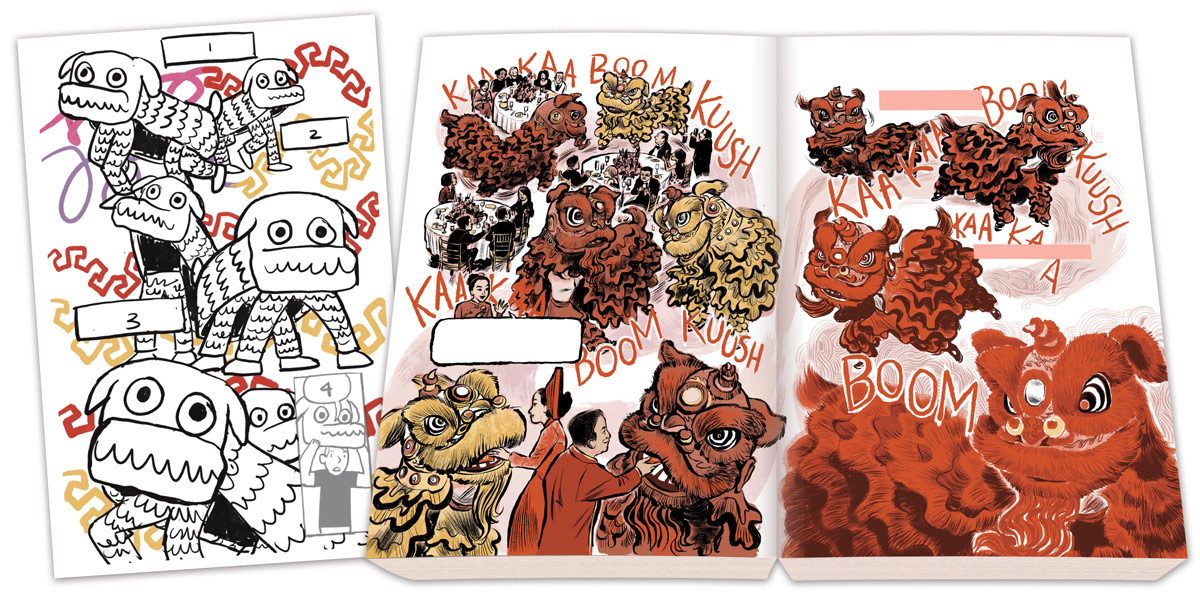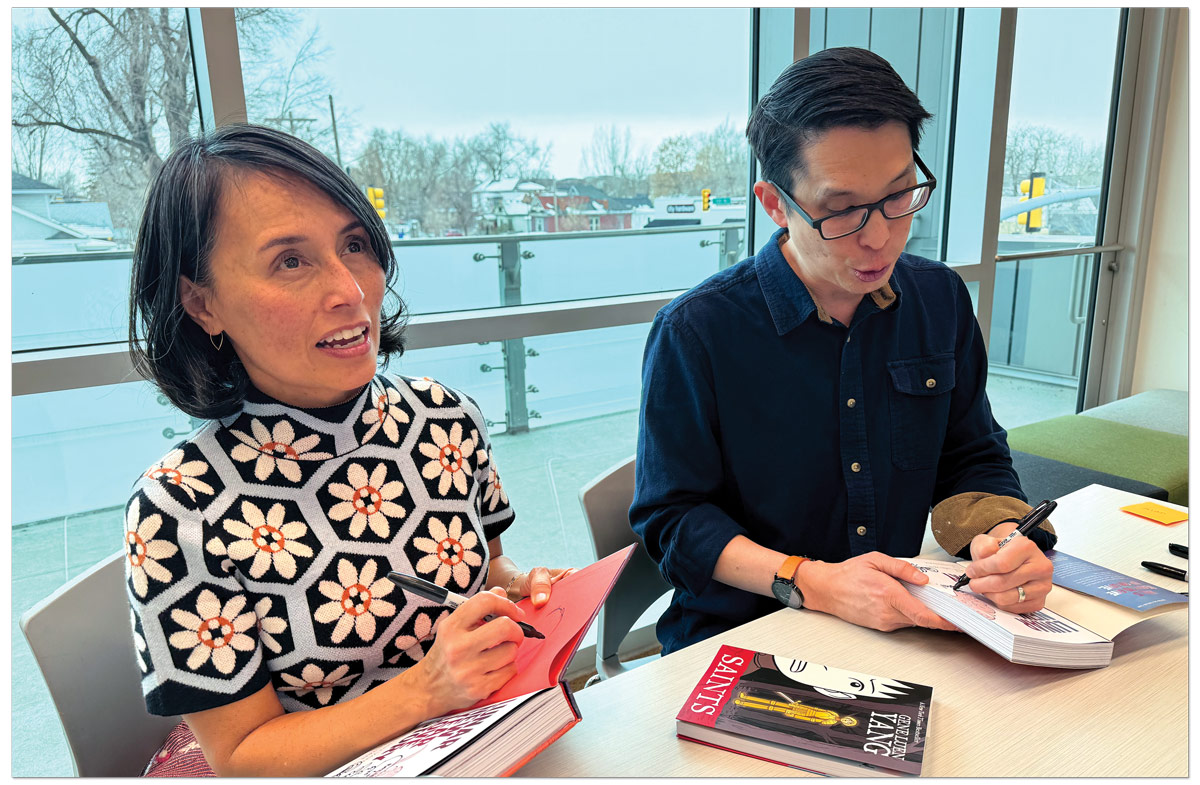A Rom-Com Dream Team: Gene Luen Yang, LeUyen Pham, and 'Lunar New Year Love Story' | The 2024 Stars Issue
The acclaimed graphic novel romance, written by Yang and illustrated by Pham, features supernatural elements, family conflict, and celebrations of Asian culture.
 |
LeUyen Pham and Gene Luen Yang |
|
|
The idea for Lunar New Year Love Story, the critically acclaimed graphic novel written by Gene Luen Yang and illustrated by LeUyen Pham, sprang from the author’s relationship with his wife, Theresa. The YA rom-com centers on Lunar New Year and Valentine’s Day, two days that played a big role in their courtship.
“When we were dating, she really did not like Valentine’s Day,” says Yang. “She thought it was like this corporate scam to get us to buy cards and candy. She wanted nothing to do with it.”
To work around that, Yang would ask her out to celebrate Lunar New Year instead.
“These two holidays are almost always right next to each other, so every time February would roll around, I would take my wife out to Lunar New Year dinner, I would buy her Lunar New Year presents, I would give her these Lunar New Year cards,” says Yang. “So, ever since then, Lunar New Year itself has had a romantic sheen to it, and I’ve always wanted to do something about the connection between these two holidays.”
Enter Yang’s longtime editor at First Second, Mark Siegel. The founder of Macmillan’s graphic novel house, Siegel also serves as its editorial and creative director. He was looking for a boy-girl romance and suggested that Yang come up with something.
So, he recalls, “I said to Gene, ‘How about the ultimate rom-com?’”
Yang threw himself into researching the genre, watching several Korean rom-coms on Netflix to get into the right headspace. Yang is Chinese American, and originally the story was going to have Korean and Chinese elements. But Pham is Vietnamese, and her influence brought with it expansion. Now there are elements of all three cultures in the book.
[Also read: Top Trends in SLJ’s Starred Books | The 2024 Stars Issue]
The result, Lunar New Year Love Story, was published in January. Set in Oakland, CA, it tells the story of a Vietnamese American girl, Valentina Tran, or Val, who loved her namesake holiday—Valentine’s Day—until a devastating family secret was revealed, shaking her faith in love. Val begins to think her whole family is cursed when it comes to romance.
In addition to romance, the novel also features family conflict, the supernatural, and celebrations of Asian culture through lion dancing. The art form began in China more than 2,000 years ago and spread to other Asian countries, such as Japan and Vietnam and is still performed today. Two dancers wear an elaborate lion costume and dance in a way that mimics the animal’s movement. The dance is usually performed at celebratory events like Lunar New Year, weddings, and grand openings, which are all depicted in the book.
For Val, an unexpected meeting with two cute lion dancers—Leslie and Jae—has the potential to restore her belief in love, but time is short. In one of the supernatural story threads, the teenager has struck a deal with Saint Valentine himself: if she doesn’t find love in a year, she will give her heart to him for safekeeping and forget about love forever.
After Val joins the dance studio where Leslie and Jae perform, Leslie makes sure he’s paired up with Val. They have undeniable chemistry as they dance together inside the lion costume.
Pham’s captivating artwork brings the story to life. Her intricate drawings enhance the romantic storyline, capturing tender moments between Val and her young suitors as well as the drama and beauty of lion dances.
 |
Spread From Lunar New Year Love Story |
A teenage girl’s story
Although Yang is also a celebrated artist, he says there was never any consideration that he would illustrate this novel.
“The only artist that we talked about was not me,” says Yang. “It was Uyen. From the very beginning, it was like a LeUyen Pham project. If she had said no, I don’t think we would have done it.”
Yang also felt strongly that he needed to work with a woman to tell a teenage girl’s story.
“To be frank, Mark is a guy. I’m a guy, and we just felt like we also needed a female voice in the creative process.”
Siegel had the same idea, bringing in Connie Hsu to be his coeditor. Hsu is the editorial director of Roaring Brook Press, another Macmillian imprint that publishes books for children and young adults.
“The first time I saw the material, it was in a very early outline phase with some script that Gene had written, and the magic was already there,” says Chu. “I fell in love with the idea of a teenager who doesn’t want to be in love, but love comes for her anyway.”
Yang relied on Hsu and Pham to help him understand life as a teenage girl. He even tapped into some of Pham’s dating experiences to shape Val’s story.
“We started trading stories about what romance and dating were like for us when we were younger,” he says. “Uyen told some stories that were so funny, some of them ended up in the book. For example, the very first date that Val goes on is actually based on a date that Uyen went on.”
 |
From left: a thumbnail sketch by Yang; final art by Pham |
A “dream pairing” of friends
Pham and Yang came to this project from different worlds. Most of Pham’s experience grew out of illustrating children’s books, while Yang has worked primarily in comics. He calls the genre the “wild west,” in that there are no real rules when it comes to how writers and artists collaborate; whereas in children’s books, there’s a greater separation between authors and illustrators.
“There was a lot more leeway with comics about how we would interact with each other, but it also helped that we were friends for so long,” says Pham.
The two have known each other for more than 20 years. During a joint Zoom call, they gently teased each other about the creative process with an easy rapport reminiscent of a brother and sister.
Yang and Pham are a “dream pairing,” says Sunny Lee, First Second senior designer and associate art director on the project, which she worked on along with First Second designer Yan Moy. Yang is a Printz Award winner for American Born Chinese (First Second, 2006) and a two-time National Book Award finalist. American Born Chinese was the first graphic novel to be nominated for a National Book Award. Yang was also the first cartoonist to hold the title of National Ambassador for Young People’s Literature. Pham received a Caldecott Honor for Bear Came Along, written by Richard T. Morris (Little, Brown, 2019), and has illustrated more than 100 books for children. She is also the cocreator of three best-selling graphic memoirs with Shannon Hale.
Pham says when Yang approached her about this project, she was at a crossroads of sorts in her professional life.
“I was kind of going through this weird moment in my career where I was trying to reassess things that I really wanted to do, and I was even canceling projects that just weren’t speaking to me anymore,” says Pham.
She had just cleared off her calendar for a few months when Yang came to her with this idea, which she didn’t take seriously at first.
“I thought we were just kind of fooling around,” says Pham. “He sent a synopsis over, and I thought, ‘This could be a lot of fun.’ And then I think it quickly turned into something real when [he] started sending over chapters.”
 |
Pham and Yang |
Eventually, Pham adds, Yang basically sent her a complete graphic novel with his own illustrations. When he pushes back against this assertion, the two laugh about it.
“When I write, even if I’m working with another artist, I’ll do the thumbnail sketches,” says Yang. “They’re not like drawings; they’re sketches. I feel like when I’m thinking visually, I’m a better writer.”
Although his drawing style is very different from Pham’s, this early work influenced the outcome, and Pham also helped to shape the writing.
“Out of all the projects that I’ve worked on, all the collaborations that I have been a part of, this is the one where I feel like we bled into each other’s roles a lot,” says Yang, who credits Pham with helping him improve Val’s story arc. “I just couldn’t crack it, and then she came up with this really simple, elegant solution.”
He also credits Pham with extending the story. Yang says he wanted to keep it under 300 pages to limit Pham’s workload, but she ended up adding about 40 pages.
“I’ve never had a project like that where I turned in the script and it ends up growing by that much, but it [grew] by that much because Uyen is actually a really formidable writer,” says Yang.
Pham describes Yang as an incredible collaborator without an ego.
“He doesn’t take offense if you say, ‘I’m not sure if that idea is working,’” she says. “He’s just like, ‘Well, what works? Let’s make sure that it works.’”
Pham’s ideas for making the lion-dancing sequences more expansive, for example, helped stretch the length of the manuscript.
“Uyen would take sequences that were fairly short and expand them into these long, beautiful spreads,” says Yang. The lion dances ended up being some of the most striking scenes in the book. In vibrant shades of primarily red, gold, and black, the lion costumes take over several spreads in ways that emphasize movement.
During a lion dance, two people are required to move as one to make the “lion” glide smoothly across the floor. Creating a graphic novel requires a bit of a dance, too, with the writer and illustrator moving in concert to create something beautiful together.
That includes comic timing. Pham explains that page-turns are key in a graphic novel. The writing has to be measured in such a way so that you turn the page at just the right moment for a joke to land properly. “Ninety percent of that, Gene established in his thumbnails. That timing is just so pinpoint accurate.”
The two also successfully weave supernatural elements into what is otherwise a realistic high school romance. Val’s communication with Saint Valentine comes across like a natural part of the story, and when one of the lion dancers sees a ghost, it doesn’t feel farfetched.
Magical realism was always a part of the story, Yang says.
“The two holidays actually have supernatural elements to them,” says Yang. “Saint Valentine, he’s a saint, and then on the Lunar New Year side, a lot of the rituals around Lunar New Year, including lion dance, are all about inviting good luck into your life and warding off evil spirits.”
 |
Lunar New Year Love Story publishing team, top: art and design crew Sunny Lee, Kirk Benshoff, and Yan Moy; bottom: editors Mark Siegel and Connie Hsu |
A complex publishing process
Editing a graphic novel is complicated, Hsu says. She had worked with Pham in the past. But collaborating on this project was like nothing she had done before, she says. And no one on the creative team had worked on a rom-com graphic novel prior to Lunar New Year Love Story.
To produce a graphic novel, “you have the script, and the words, and the pacing, and the page count, and then you get to the art, and that’s a whole other process too,” says Hsu. “It gets even more complicated if it’s a graphic novel written by an author who’s not the illustrator. You have an illustrator who only does the book up to inks, and then you bring in a colorist. Graphic novels just require a lot more planning, precision, procedure.”
A novel of this nature also requires careful consideration on the design side. Kirk Benshoff, creative director at Macmillan, says that his job often begins with pulling together assets, such as fonts and templates, that the team will need to bring a graphic novel to life.
“We carve out a window of time to do what we call proof-of-concept pages, where we’re looking at examples of all the visual tools that will be in the book,” says Lee. “Are there going to be color palette changes because of a dream sequence or a flashback scene? That gives everybody a chance to weigh in, and then we ultimately take those pages and send them out to test for color.”
When that’s done, the illustrator can feel confident in how things will look on the page. A big part of Benshoff’s job is handling logistics while the illustrator is navigating a lot of steps.
“Once [Pham] is done penciling the book, then she’s inking it and lettering it while she’s inking, before circling back to add the color,” says Benshoff. “Through all of that, she’s getting feedback and notes from Gene, from Connie, and from Mark.”
All that feedback often results in adjustments, which can make for an intense endeavor.
In addition, the creators were under incredible time constraints to finish the book. While some graphic novels take more than five years to produce, they had an outline in place by March 2021 and went to press in June 2023. The goal was to publish it by January 2024, ahead of Lunar New Year.
“To be able to do that within the comics world is a pretty phenomenal feat,” says Hsu. “[LeUyen] has that unique capability to work quickly, but also never sacrifice quality.”
Despite the complex challenges, everyone who worked on Lunar New Year Love Story described the process as fun. And critics praised the published book’s storyline and art, along with its representation of Asian American teens.
Yang says he hopes the book will serve as a mirror for young Asian readers.
“We really did write and draw this book out of our own lives,” says Yang. “We’re both Asian American. We live these Asian American lives, and there is a diversity within Asian America that we wanted to reflect.”
Pham adds that the story also has universal appeal.
“It’s not just Asian kids that are picking it up,” says Pham. “It’s all kinds of kids that are picking up. And that, to me, is massive progress.”
Writer and editor Marva Hinton hosts the “ReadMore” podcast.
RELATED
The job outlook in 2030: Librarians will be in demand
The job outlook in 2030: Librarians will be in demand
ALREADY A SUBSCRIBER? LOG IN
We are currently offering this content for free. Sign up now to activate your personal profile, where you can save articles for future viewing







Add Comment :-
Be the first reader to comment.
Comment Policy:
Comment should not be empty !!!